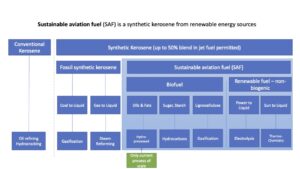2050 may appear a long time off yet. But when we consider the challenges involved, the deadline for airlines achieving net-zero aviation looms ever closer.
In July last year, the UK Government’s Department of Transport (DoT) published its ‘Jet Zero Strategy’, an 83-page document aimed at delivering net-zero aviation by 2050.
The report identifies 6 policy measures, namely System Efficiency, Zero Emission Flight (ZAF), Markets & Removals, Influencing Consumers, Addressing non C02, and Sustainable Aviation Fuels (SAF).
Throughout the document, the measures appear to receive equal focus and importance, although SAF is the area that gains more media and industry interest.
This is not surprising when, according to 2019 figures, UK aviation used 12.3 million tonnes of jet fuel accounting for 8% of all UK greenhouse gas emissions. It is a notoriously difficult sector to decarbonize.
Future Challenges
There is still some confusion surrounding SAF, often perceived as one singular product, when in fact it is a portfolio or often referred to as a ‘pathway’ of technologies as the below chart illustrates.
Each technology faces major challenges in their specific development and achieving the required production scale / infrastructure by 2050.

Most of today’s available SAF derive from fats, oils, and greases – also referred to as FOGs and can be used as drop in aviation fuel which can be blended in a ratio of up to 50% with conventional jet fuel for use in existing aircraft without modification. They could therefore provide both short and long-term CO2 emissions savings.
Back to the Future
The innovation behind SAF is impressive and reminiscent of the time-travelling DeLorean in the 1980’s movie, ‘Back to the Future,’ in which the DeLorean was powered by household waste. That scene brought much laughter in cinemas all around the World. How would audiences have responded to cooking oil powered aeroplanes back then?
But before we get nostalgic about Back to the Future, we need to get back to the present! Just last week, the UK’s leading scientific academy, the Royal Society issued a report that shone a light on the Jet Zero Strategy SAF ambitions.
The report said, that producing sustainable aviation fuel to supply the UK’s ‘net zero’ objectives would require enormous quantities of UK agricultural land or renewable electricity to keep flying at today’s levels. And that meeting existing UK aviation demand entirely with energy crops would require around half of UK agricultural land.
It went on to describe the challenges surrounding infrastructure, regulations, cost, and the overall difficulties in achieving the required scale of production just 27 years from now.
Innovation & Collaboration
It’s a good thing that policy makers are held to account and challenged on ambitions as important as this. But no one is denying the size of the challenge which will require an unprecedented degree of innovation and collaboration – and much more besides.
History has shown us that humans are very good problem solvers, and we are particularly effective at adapting to technological changes and finding innovative solutions, often through trial and error.
The question isn’t if we can achieve this, but if 27 years is a sufficient timescale?
If we had the DeLorean Time Machine, we could travel back 27 years to 1996. We would probably be surprised when we realise how far technology has advanced since then – not least in the aerospace sector.
We could also travel forward 27 years to 2050 – and may be equally surprised at how far we have come – and with a fair wind, achieved our net-zero ambitions.
Only time will tell.

